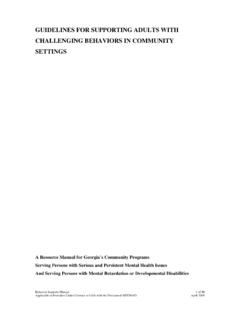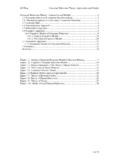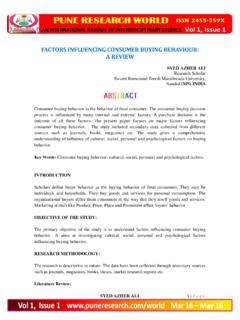Transcription of CHAPTER 12 - THE INFLUENCE OF CULTURE ON CONSUMER …
1 271 Copyright 2010 Pearson Education, Inc. CHAPTER 11 INFLUENCE of CULTURE on CONSUMER behavior LEARNING OBJECTIVES After studying this CHAPTER students should be able to understand: 1. What CULTURE is and how it impacts CONSUMER behaviors. 2. How CULTURE acts as an invisible hand that guides consumption-related attitudes, values and behavior . 3. How CULTURE sets standards for what satisfies consumers needs. 4. How CULTURE is learned and expressed in language, symbols, and rituals. 5. How consumers are always adapting to CULTURE -related experiences. 6. How the i mpact of CULTURE on CONSUMER behavior is measured.
2 7. How core cultural values impact American consumers. 8. How the American CULTURE became a shopping CULTURE . CHAPTER SUMMARY The study of CULTURE is the study of all aspects of a society. It is the language, knowledge, laws, and customs that give society its distinctive character and personality. In the context of CONSUMER behavior , CULTURE is defined as the sum total of learned beliefs, values, and customs that serve to regulate the CONSUMER behavior of members of a particular society. Beliefs and values are guides for CONSUMER behavior ; customs are unusual and accepted ways of behaving.
3 The impact of CULTURE is so natural and ingrained that its INFLUENCE on behavior is rarely noted. Yet, CULTURE offers order, direction, and guidance to members of society in all phases of human problem solving. CULTURE is dynamic, and gradually and continually evolves to meet the needs of society. CULTURE is learned as part of social experience. Children acquire from their environment a set of beliefs, values, and customs that constitute CULTURE ( , they are encultured). These are acquired through formal learning, informal learning, and technical learning. Advertising enhances formal learning by reinforcing desired modes of behavior and expectations; it enhances informal learning by providing models for behavior .
4 CULTURE is communicated to members of the society through a common language and through commonly shared symbols. Because the human mind has the ability to absorb and process symbolic communication, marketers can successfully promote both tangible and intangible products and product concepts to consumers through mass media. 272 Copyright 2010 Pearson Education, Inc. All the elements of the marketing mix serve to communicate symbolically with the audience. Products project an image of their own; so does promotion. Price and retail outlets symbolically convey images concerning the quality of the product.
5 The elements of CULTURE are transmitted by three pervasive social situations: the family, the church, and the school. A fourth social institution that plays a major role in the transmission of CULTURE is the mass media, both through editorial content and through advertising. A wide range of measurement techniques are used to study CULTURE . The range includes projective techniques, attitude measurement methods, field observation, participant observation, content analysis, and value measurement survey techniques. A number of core values of the American people are relevant to the study of CONSUMER behavior .
6 These include achievement and success, activity, efficiency and practicality, progress, material comfort, individualism, freedom, conformity, humanitarianism, youthfulness, and fitness and health. Because each of these values varies in importance to the members of our society, each provides an effective basis for segmenting CONSUMER markets. CHAPTER OUTLINE INTRODUCTION 1. The study of CULTURE is a challenging undertaking because its primary focus is on the broadest component of social behavior in an entire society. 2. In contrast to the psychologist, who is principally concerned with the study of individual behavior , or the sociologist, who is concerned with the study of groups, the anthropologist is primarily interested in identifying the very fabric of society itself.
7 **Use Figure # Here** WHAT IS CULTURE ? 1. Given the broad and pervasive nature of CULTURE , its study generally requires a detailed examination of the character of the total society, including such factors as language, knowledge, laws, religions, food customs, music, art, technology, work patterns, products, and other artifacts that give a society its distinctive flavor. 2. In a sense, CULTURE is a society s personality. For this reason, it is not easy to define its boundaries. 3. CULTURE is the sum total of learned beliefs, values, and customs that serve to direct the CONSUMER behavior of members of a particular society.
8 4. Beliefs consist of the very large number of mental or verbal statements that reflect a person s particular knowledge and assessment of something. 273 Copyright 2010 Pearson Education, Inc. 5. Values also are beliefs, however, values differ from other beliefs because they must meet the following criteria: a) They are relatively few in number. b) They serve as a guide for culturally appropriate behavior . c) They are enduring or difficult to change. d) They are not tied to specific objects or situations. e) They are widely accepted by the members of a society. 6. In a broad sense, both values and beliefs are mental images that affect a wide range of specific attitudes that, in turn, INFLUENCE the way a person is likely to respond in a specific situation.
9 7. Customs are overt modes of behavior that constitute culturally approved or acceptable ways of behaving in specific situations. a) Customs consist of everyday or routine behavior . b) Although beliefs and values are guides for behavior , customs are usual and acceptable ways of behaving. c) An understanding of various cultures can help marketers predict CONSUMER acceptance of their products. **Use Key Term CULTURE Here; Use Learning Objective # Here; Use Discussion Question #1 Here; Use Exercise #3 Here** THE INVISIBLE HAND OF CULTURE 1. The impact of CULTURE is so natural and automatic that its INFLUENCE on behavior is usually taken for granted.
10 2. Often, it is only when we are exposed to people with different cultural values or customs that we become aware of how CULTURE has molded our own behavior . 3. Consumers both view themselves in the context of their CULTURE and react to their environment based upon the cultural framework that they bring to that experience. Each individual perceives the world through his or her own cultural lens. 4. CULTURE can exist and sometimes reveal itself at different perceived or subjective levels. 5. Those interested in CONSUMER behavior would be most concerned with three levels of subjective CULTURE : a) Supranational level reflects the underlying dimensions of CULTURE that impact multiple cultures or different societies.

















